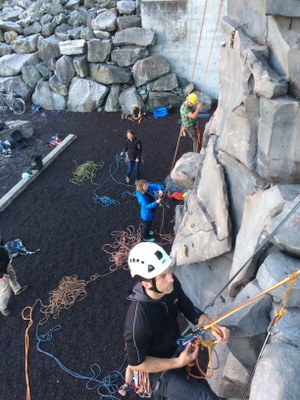
Field trip: Climbing Self Rescue II
Scenario Day - Mountaineers Seattle Program Center
Self Rescue Field Trip 2D
- Sun, Nov 11, 2018
- Seattle Climbing
- Climbing
- Intermediate Alpine
- Adults
- Moderate
- 5 (16 capacity)
- 3 (8 capacity)
- Cancellation & Refund Policy
Meet at 8:00 AM in the basement at the Seattle Program Center. This on-site field trip runs until 4:00 PM.
In order to continue the Self Rescue 2 module, each student will show proficiency regarding the following techniques from the Self Rescue 1 module:
- ascending techniques
- descending techniques
- counterbalance rappel
- tandem rappel
- counter-balance rappel
- transferring from a rope to an anchor, and an anchor to a rope
- belay escape
- rescue spider or equivalent (using a cordelette to create a Cow’s Tail with plenty of cord left to tie a Munter-Mule-Back up)
Learning Objectives for Self Rescue 2 Module
- Discuss possible self-rescue scenarios for fallen/injured leader.
- Practice one scenario and become proficient in rescue techniques for that scenario.
- Discuss possible pitfalls and problems that students may encounter.
Scenario: The leader has fallen with more than half a rope length out on vertical terrain and is unconscious.
- Lower your partner as far as you safely can to an (possible) anchor point.
- Escape the belay so that the rope is connected to the anchor with a MMO and back up figure 8 on a bight.
- Ascend the rope to your partner. (Note that you rely on your partner as a counterbalance while you ascend and you rely on their top pieces of protection to be bomber enough to hold both of you while you ascend.)
- Build an anchor near your partner and attach yourself to it.
- Attach your partner to this anchor with a Cow’s Tail and LRH (or Rescue Spider) and back-up it up with their personal anchor.
- Transfer your partner’s weight from the rope to this new anchor.
- SEE OPTION 1 & OPTION 2 below.
-
Attach yourself to the free tail of the Cow’s Tail or Spider, transfer your weight to it, and remove your ascending system.
-
Set up a rappel device on the head of the Cow’s Tail or Spider and an autoblock on your partner’s harness belay loop. Hand-tighten the rappel system.
-
Transfer all tension to the rappel rope using the Mariner’s hitch (LRH). Remove your partner’s and your backups (personal anchors). You’re on rappel.
-
Continue building anchors and descending systems as needed.
Option 1 (Note, there are other safe options not included here.)
- Attach the rope to the anchor with a prusik (one of yours may still be on the rope) so you prevent the possibility of losing it.
- Use a carabiner block-and-tackle to create enough slack in the rope to untie it from your partner.
- Pull the rope from the upper pieces of protection and attach it to the anchor with a clove hitch backed up with a figure 8. Leave enough slack in the line to rappel.
- Rappel the rope to the belay anchor and disassemble the anchor.
- Connect ascending system to the rope, weight it and remove your rappel device.
- Ascend to your partner.
Option 2 (Note, there are other safe options not included here.)
- Attach the rope to the anchor with a prusik (one of yours may still be on the rope) to minimize the counterbalance effect on your partner and to minimize the damage if the top piece of protection fails.
- Use your ascending rig to descend the rope to the lower anchor.
- Transfer your weight to the lower anchor and remove your ascending rig.
- Use the MMO at the lower anchor to transfer your partner’s weight from the rope to the higher anchor.
- Reattached your ascending rig to the rope and disassemble the lower anchor.
- Ascend to your partner.
Required Equipment
Gear you would take on a multi pitch rock climb
